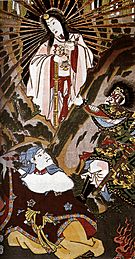Japanese mythology facts for kids
Japanese mythology is a collection of ancient stories and beliefs from Japan. It mixes ideas from two main religions: Shinto and Buddhism. Shinto, especially, has many different kami, which are Japanese words for "gods" or "spirits."
Most of the Japanese myths we know today come from old books. The most important ones are the Kojiki and the Nihonshoki. The Kojiki, or "Record of Ancient Things," is the oldest known book. It's full of myths, legends, and early Japanese history. Other books like the Shintoshu explain the origins of Japanese gods from a Buddhist viewpoint. The Hotsuma Tsutae offers a very different version of these myths.
One special thing about Japanese mythology is how it explains the origin of the Imperial family. It says they have a divine, or god-like, connection. The Japanese word for the Emperor, tennō (天皇), actually means "heavenly emperor".
Contents
Important Books of Myths
Japanese mythology is mostly found in very old writings. These books help us understand the ancient beliefs and stories of Japan.
The Kojiki
The Kojiki is the oldest and most important book of Japanese myths. It was finished in the year 712 CE. This book tells stories about how the world was created and how the gods came to be. It also includes legends about the early emperors of Japan. The Kojiki is a key source for understanding the origins of the Japanese people and their rulers.
The Nihonshoki
The Nihonshoki, also known as the "Chronicles of Japan," was completed in 720 CE. It is similar to the Kojiki but offers more detailed historical accounts. The Nihonshoki also includes many myths and legends, often with slightly different versions of the stories found in the Kojiki. Both books are essential for studying Japanese mythology.
Other Myth Collections
While the Kojiki and Nihonshoki are primary sources, other texts also contribute to Japanese mythology. The Shintoshu explains the origins of Japanese gods from a Buddhist perspective. This shows how Shinto and Buddhist ideas mixed over time in Japan. The Hotsuma Tsutae is another book that presents a unique and different version of these ancient myths.
Gods and Spirits: Kami
In Japanese mythology, the most important beings are called kami. These are not just gods, but also spirits, forces of nature, and even important ancestors. The Shinto religion, which is deeply connected to Japanese mythology, believes in a very large number of kami.
Types of Kami
Kami can be found everywhere in nature. There are kami of mountains, rivers, trees, and even rocks. Some kami are linked to specific places, like a shrine. Others are connected to important ideas, like creation, harvest, or protection. Many kami are also the spirits of important people who have passed away.
Worshipping Kami
People in Japan often visit Shinto shrines to show respect to the kami. At these shrines, they can offer prayers and gifts. This helps them feel connected to the spiritual world and the ancient traditions of Japan.
The Imperial Family's Divine Connection
A very special part of Japanese mythology is how it explains the origin of the Imperial family. According to these myths, the emperors are direct descendants of the gods.
Heavenly Emperor
The Japanese word for the Emperor, tennō (天皇), means "heavenly emperor". This name reflects the belief that the Emperor's family has a divine, or god-like, origin. This idea has been very important throughout Japanese history. It gave the emperors a special and respected position in society.
Amaterasu and Jimmu
One of the most important kami is Amaterasu Ōmikami, the Sun Goddess. Myths say that the first Emperor of Japan, Jimmu Tennō, was a direct descendant of Amaterasu. This connection linked the Imperial family directly to the most powerful gods. It showed that they were chosen by the heavens to rule Japan.
Related pages
|
Japanese Mythology & Folklore |
|
|---|---|
|
Mythic Texts and Folktales: |
Images for kids
See also
 In Spanish: Mitología japonesa para niños
In Spanish: Mitología japonesa para niños






